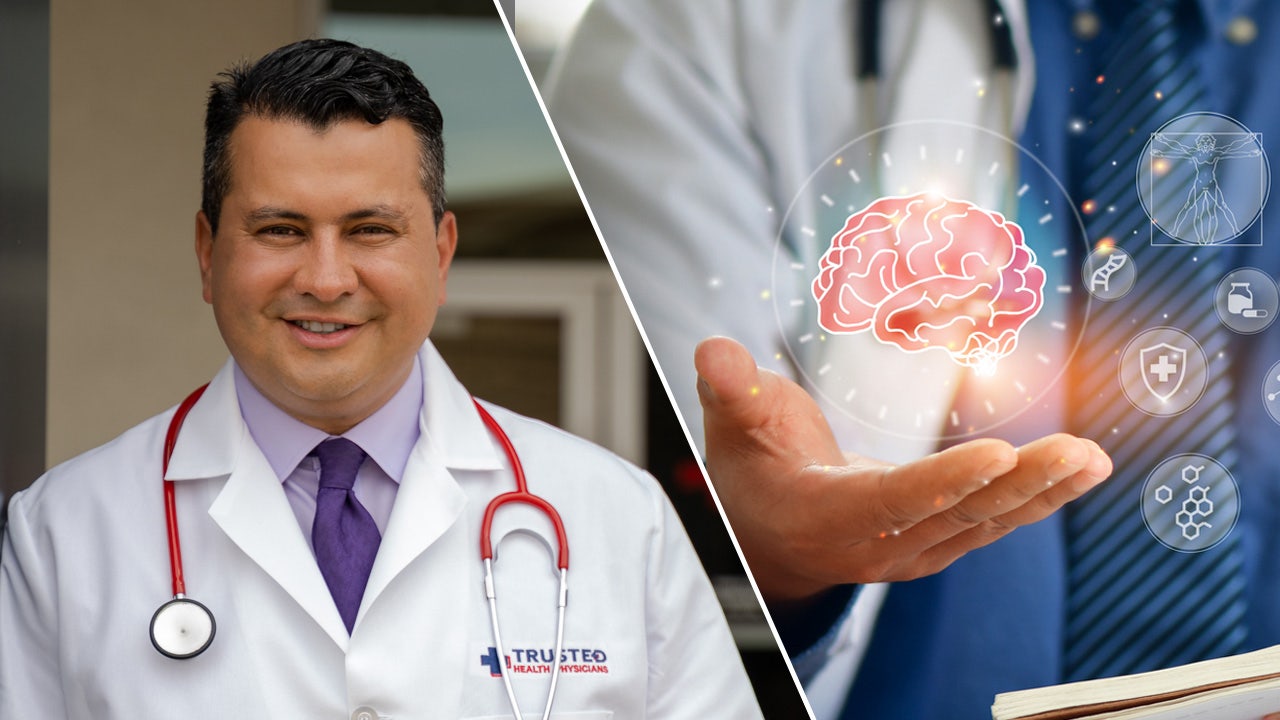Health
Ask a doc: 25 burning questions about AI and health care answered by an expert

As artificial intelligence continues to move into the health care arena — showing up everywhere from ultrasound screenings to drug development to doctors’ offices — some patients may be uncertain, curious or concerned about how it will impact them or their medical care.
Dr. Harvey Castro, an emergency medicine physician in Coppell, Texas, is also a consultant and speaker on AI and ChatGPT in health care.
Castro shared with Fox News Digital some of the most common questions patients are asking about the use of AI in the medical field — and provided his responses.
WHAT IS ARTIFICIAL INTELLIGENCE (AI)?
Diving right in here …
Understanding AI in health care
1. What is AI — and how is it used in health care?
“AI, or artificial intelligence, is a technology that mimics human intelligence. In health care, it’s used to analyze medical data, assist in diagnoses and personalize treatment plans.”
He added, “It’s like having an extra set of expert eyes to help us provide the best care for you.”
Dr. Harvey Castro, an emergency medicine physician in Coppell, Texas, is also a consultant and speaker on AI and ChatGPT in health care. In this piece, he shares the answers to 25 burning questions about AI and health care. (Dr. Harvey Castro/iStock)
2. How is AI being used in diagnosis or treatment?
“AI can analyze medical records, lab results and imaging studies to assist us in making a more accurate diagnosis. It’s a tool that supports our clinical judgment, ensuring that we consider all available information in your treatment plan.”
3. How does AI personalize health care?
“AI allows us to tailor treatment to your unique needs by analyzing your health data. It’s like having a personalized medical assistant that helps us choose the best treatment options for you, considering your medical history and individual characteristics.”
4. How does AI complement the care provided by human health care professionals?
“AI is a valuable tool that enhances our abilities — not replaces them.”
AS AI SHOWS UP IN DOCTORS’ OFFICES, MOST PATIENTS ARE GIVING PERMISSION AS EXPERTS ADVISE CAUTION
“It can process information quickly and identify patterns we might miss, allowing us to focus more on you, the patient, and provide personalized care.”
5. Will AI replace human health care providers?
“No. AI won’t replace human health care providers. It’s a tool that assists us, but it lacks the empathy, ethical judgment and personal touch that only a human can provide. We work together with AI to offer you the best care possible.”

“AI won’t replace human health care providers,” Dr. Castro said, because it “lacks the empathy, ethical judgment and personal touch that only a human can provide.” (Dr. Harvey Castro)
Benefits and risks
6. What are the benefits and potential risks of using AI in health care?
“The benefits of AI include more accurate diagnoses, personalized treatments and efficient care. However, like any technology, it must be used responsibly. Potential risks might include data privacy concerns or biases in AI models. But we take all necessary precautions to mitigate these risks.”
7. Is AI safe to use in medical procedures?
“Yes, AI is rigorously tested and used to enhance our capabilities in medical procedures. For example, in surgery, AI can guide us precisely, improving outcomes and recovery times. Your safety is always our priority.”
8. How can I benefit from AI in my health care journey?
“AI can empower you to take an active role in your health. From personalized treatment plans to AI-powered apps that help you manage chronic conditions, AI is a valuable ally in your health care journey, supporting you and your medical team.”
Privacy and security
9. How does AI ensure the privacy and security of my health data?
“AI systems in health care adhere to strict privacy and security regulations. Your health data is encrypted and used responsibly.”
NEW AI TECH AIMS TO DETECT THE ORIGIN OF CANCERS FOR OPTIMAL TREATMENTS: ‘AN IMPORTANT STEP’
“We take your privacy seriously,” added Dr. Castro, “and ensure that all information is handled with the utmost care and confidentiality.”

Dr. Castro compared AI to “having an extra set of expert eyes to help us provide the best care for you.” (Dr. Harvey Castro)
10. How are AI systems in health care adhering to strict privacy and security regulations?
“AI systems comply with legal and ethical standards, including data protection laws. We implement robust security measures to protect your information, ensuring that it’s used solely for your care and for improving health care delivery.”
Ethical considerations and biases
11. Are there any biases in the AI models used for my care?
“We strive to use AI models trained on diverse and representative data. However, biases can exist in any system. We always combine AI’s insights with our professional judgment to ensure your care is fair and appropriate.”
12. What are the limitations of AI in health care?
“While AI offers incredible potential, it has limitations. It requires quality data and human oversight. For example, an AI model trained on specific data may perform poorly on others. We’re aware of these limitations and use AI responsibly in your care.”
13. How does AI address ethical principles in development and deployment?
“Ethical principles guide the development and use of AI in health care. From data privacy to fairness and transparency, we adhere to ethical guidelines to ensure that AI is used to enhance, not hinder, your care.”

“We always combine AI’s insights with our professional judgment to ensure your care is fair and appropriate,” said Dr. Castro, based in Coppell, Texas. (iStock)
14. How could AI affect health care workers’ job security and career advancement?
“AI is a tool that complements, not replaces, health care workers. It can handle routine tasks, allowing us to focus on patient care. Far from threatening job security, AI opens new opportunities for growth and innovation in health care.”
Patient empowerment and options
15. Can I opt out of AI-driven care if I choose to — and what are the alternatives?
“Absolutely. The choice is yours. We can discuss alternative options if you prefer to avoid involving AI in your care.”
AI TECH AIMS TO DETECT BREAST CANCER BY MIMICKING RADIOLOGISTS’ EYE MOVEMENTS: ‘A CRITICAL FRIEND’
“Your comfort and trust are paramount. We’ll work together to find the best approach for you.”
16. How does AI empower patients by providing personalized care and reducing wait times?
“AI helps us quickly understand your unique health needs, leading to personalized care. It also streamlines processes, reducing wait times. It’s like having a customized health care team working efficiently to provide you with the best care possible.”

“AI is a valuable tool that enhances our abilities — not replaces them.” (Dr. Harvey Castro)
17. How can AI-powered apps help me manage my chronic conditions?
“AI-powered apps can monitor your vital signs, provide real-time feedback and even remind you to take medications. They’re like having a personal health coach in your pocket, effectively supporting you in managing your chronic conditions.”
Technology and innovation
18. How are AI-powered surgical robots assisting surgeons in performing precise procedures?
“AI-powered surgical robots are like an extension of the surgeon’s hands, allowing for exact and minimally invasive procedures. They assist us in performing complex surgeries with greater accuracy, improving your recovery and outcomes.”
19. How does AI analyze complex medical data, assist in diagnosis and predict patient outcomes?
“AI can quickly analyze vast amounts of data, identifying patterns and correlations that might be challenging for humans to detect. It assists us in making accurate diagnoses and even predicting outcomes, ensuring that we provide the most effective care for you.”
20. What are the latest innovations in AI that are transforming health care delivery?
“Innovations in AI are continually emerging, from personalized medicine to virtual health assistants. These technologies are transforming how we deliver care, making it more personalized, efficient and accessible.”
NEW AI ULTRASOUND TECH IS FIRST TO LAND FDA APPROVAL TO ENHANCE PRENATAL CARE: ‘BETTER HEALTH OUTCOMES’
“It’s an exciting time for health care, and we’re committed to leveraging these innovations for your benefit.”
21. How is AI contributing to research and the development of new medical technologies?
“AI accelerates research by analyzing complex data and identifying new insights. It’s like having a team of expert researchers working around the clock, leading to new medical technologies and treatments that can improve patient care.”

“AI has the potential to enhance health equity by making quality care accessible to more people,” Dr. Castro said. (iStock)
22. How is AI being integrated into telehealth and remote patient monitoring?
“AI enhances telehealth by enabling remote monitoring and personalized care, even when you’re at home. It’s like having a virtual health care provider, ensuring you receive continuous care and support no matter where you are.”
CLICK HERE TO SIGN UP FOR OUR HEALTH NEWSLETTER
23. How are health care leaders and future leaders using AI to work smarter and faster?
“Health care leaders embrace AI to enhance decision-making, streamline workflows and improve patient outcomes. It’s a tool that enables us to work smarter, not harder, ensuring that we provide the best possible care for you.”
Accessibility and equity
24. How does AI address health equity and the patient-physician relationship?
“AI has the potential to enhance health equity by making quality care accessible to more people. It also supports the patient-physician relationship by allowing us to spend more time with you, understand your needs and provide personalized care.”

“AI systems in health care adhere to strict privacy and security regulations,” Castro told Fox News Digital. “Your health data is encrypted and used responsibly.” (iStock)
25. Is there a disparity in access to AI-powered health care, particularly in underserved communities?
“While AI offers excellent promise, disparities in access can exist.”
“We’re committed to addressing these challenges and ensuring that AI-powered health care is accessible to all, regardless of location or socioeconomic status.”

Health
Children exposed to higher fluoride levels found to have lower IQs, study reveals

The debate about the benefits and risks of fluoride is ongoing, as RFK Jr. — incoming President Trump’s pick for HHS secretary — pushes to remove it from the U.S. water supply.
“Fluoride is an industrial waste associated with arthritis, bone fractures, bone cancer, IQ loss, neurodevelopmental disorders and thyroid disease,” RFK wrote in a post on X in November.
A new study published in JAMA Pediatrics on Jan. 6 found another correlation between fluoride exposure and children’s IQs.
RFK JR. CALLS FOR REMOVAL OF FLUORIDE FROM DRINKING WATER, SPARKING DEBATE
Study co-author Kyla Taylor, PhD, who is based in North Carolina, noted that fluoridated water has been used “for decades” to reduce dental cavities and improve oral health.
Fluoride exposure has been linked to a variety of negative health effects, yet benefits oral health. (iStock)
“However, there is concern that pregnant women and children are getting fluoride from many sources, including drinking water, water-added foods and beverages, teas, toothpaste, floss and mouthwash, and that their total fluoride exposure is too high and may affect fetal, infant and child neurodevelopment,” she told Fox News Digital.
The new research, led by scientists at the National Institute of Environmental Health Sciences (NIEHS), analyzed 74 epidemiological studies on children’s IQ and fluoride exposure.
FEDERAL JUDGE ORDERS EPA FURTHER REGULATE FLUORIDE IN DRINKING WATER DUE TO CONCERNS OVER LOWERED IQ IN KIDS
The studies measured fluoride in drinking water and urine across 10 countries, including Canada, China, Denmark, India, Iran, Mexico, Pakistan, New Zealand, Spain and Taiwan. (None were conducted in the U.S.)
The meta-analysis found a “statistically significant association” between higher fluoride exposure and lower children’s IQ scores, according to Taylor.
“[It showed] that the more fluoride a child is exposed to, the more likely that child’s IQ will be lower than if they were not exposed,” she said.

Scientists found a “statistically significant association” between higher fluoride exposure and lower children’s IQ scores. (iStock)
These results were consistent with six previous meta-analyses, all of which reported the same “statistically significant inverse associations” between fluoride exposure and children’s IQs, Taylor emphasized.
The research found that for every 1mg/L increase in urinary fluoride, there was a 1.63-point decrease in IQ.
‘Safe’ exposure levels
The World Health Organization (WHO) has established 1.5mg/L as the “upper safe limit” of fluoride in drinking water.
“There is concern that pregnant women and children are getting fluoride from many sources.”
Meanwhile, the U.S. Public Health Service recommends a fluoride concentration of 0.7 mg/L in drinking water.
“There was not enough data to determine if 0.7 mg/L of fluoride exposure in drinking water affected children’s IQs,” Taylor noted.
FDA BANS RED FOOD DYE DUE TO POTENTIAL CANCER RISK
Higher levels of the chemical can be found in wells and community water serving nearly three million people in the U.S., the researcher noted.
She encouraged pregnant women and parents of small children to be mindful of their total fluoride intake.

Nearly three million people have access to wells and community water with fluoride levels above the levels suggested by the World Health Organization. (iStock)
“If their water is fluoridated, they may wish to replace tap water with low-fluoride bottled water, like purified water, and limit exposure from other sources, such as dental products or black tea,” she said.
“Parents can use low-fluoride bottled water to mix with powdered infant formula and limit use of fluoridated toothpaste by young children.”
For more Health articles, visit www.foxnews.com/health.
While the research did not intend to address broader public health implications of water fluoridation in the U.S., Taylor suggested that the findings could help inform future research into the impact of fluoride on children’s health.
Dental health expert shares cautions
In response to this study and other previous research, Dr. Ellie Phillips, DDS, an oral health educator based in Austin, Texas, told Fox News Digital that she does not support water fluoridation.

The study researcher encouraged parents of small children to be mindful of their total fluoride intake. (iStock)
“I join those who vehemently oppose public water fluoridation, and I question why our water supplies are still fluoridated in the 21st century,” she wrote in an email.
“There are non-fluoridated cities and countries where the public enjoy high levels of oral health, which in some cases appear better than those that are fluoridated.”
CLICK HERE TO SIGN UP FOR OUR HEALTH NEWSLETTER
Phillips called the fluoride debate “confusing” even among dentists, as the American Dental Association (ADA) advocates for fluoride use for cavity prevention through water fluoridation, toothpaste and mouthwash — “sometimes in high concentrations.”

Fluoride is used in water, toothpaste and mouthwash to help prevent cavities. (iStock)
“[But] biologic (holistic) dentists generally encourage their patients to fear fluoride and avoid its use entirely, even if their teeth are ravaged by tooth decay,” she said.
“Topical fluoride is beneficial, while systemic consumption poses risks.”
Phillips encouraged the public to consider varying fluoride compounds, the effect of different concentrations and the “extreme difference” between applying fluoride topically and ingesting it.
“Topical fluoride is beneficial, while systemic consumption poses risks,” she cautioned.
“Individuals must take charge of their own oral health using natural and informed strategies.”
The study received funding from the National Institute of Environmental Health Sciences (NIEHS), the National Institutes of Health (NIH) and the Intramural Research Program.
Health
Treating Other Diseases With Ozempic? Experts Weigh In | Woman's World

Sign Up
Create a free account to access exclusive content, play games, solve puzzles, test your pop-culture knowledge and receive special offers.
Already have an account? Login
Use left and right arrow keys to navigate between menu items.
Use escape to exit the menu.
Health
FDA bans red food dye due to potential cancer risk

FDA looks to ban red food dye
Celebrity fitness trainer Jillian Michaels joins ‘Hannity’ to discuss the possibility of the FDA banning red food dye.
The U.S. Food and Drug Administration (FDA) has officially banned red dye — called Red 3, or Erythrosine — from foods, dietary supplements and ingested medicines, as reported by the Associated Press on Wednesday.
Food manufacturers must remove the dye from their products by January 2027, while drug manufacturers will have until January 2028 to do so, AP stated.
Any foods imported into the U.S. from other countries will also be subject to the new regulation.
RED FOOD DYE COULD SOON BE BANNED AS FDA REVIEWS PETITION
“The FDA is taking action that will remove the authorization for the use of FD&C Red No. 3 in food and ingested drugs,” said Jim Jones, the FDA’s deputy commissioner for human foods, in a statement.
The U.S. Food and Drug Administration has officially banned red dye — called Red 3, or Erythrosine — from foods, dietary supplements and ingested medicines (iStock)
“Evidence shows cancer in laboratory male rats exposed to high levels of FD&C Red No.3,” he continued. “Importantly, the way that FD&C Red No. 3 causes cancer in male rats does not occur in humans.”
The synthetic dye, which is made from petroleum, is used as a color additive in food and ingested drugs to give them a “bright cherry-red color,” according to an online statement from the FDA.

Food manufacturers must remove the dye from their products by January 2027, while drug manufacturers will have until January 2028 to do so. (iStock)
The petition to ban the dye cited the Delaney Clause, which states that the agency cannot classify a color additive as safe if it has been found to induce cancer in humans or animals.
The dye was removed from cosmetics nearly 35 years ago due to potential cancer risk.
CLICK HERE TO SIGN UP FOR OUR HEALTH NEWSLETTER
“This is a welcome, but long overdue, action from the FDA: removing the unsustainable double standard in which Red 3 was banned from lipstick but permitted in candy,” said Dr. Peter Lurie, director of the group Center for Science in the Public Interest, which led the petition effort, as reported by AP.

Nearly 3,000 foods are shown to contain Red No. 3, according to Food Scores, a database of foods compiled by the Environmental Working Group. (iStock)
Dr. Marc Siegel, clinical professor of medicine at NYU Langone Health and Fox News senior medical analyst, applauded the FDA’s ban.
“It was a long time coming,” he told Fox News Digital. “It’s been more than 30 years since it was banned from cosmetics in the U.S. due to evidence that it is carcinogenic in high doses in lab rats. There needs to be a consistency between what we put on our skin and what we put into our mouths.”
“There needs to be a consistency between what we put on our skin and what we put into our mouths.”
Siegel said he believes the FDA’s decision could be tied to the incoming new head of the Department of Health and Human Services, Robert F. Kennedy Jr.
“They knew it would have happened anyway under RFK Jr.,” he said. “It is already banned or severely restricted in Australia, Japan and the European Union.”

The food additive also “drew kids in” to a diet of empty calories and ultraprocessed foods, one doctor stated. (iStock)
The food additive also “drew kids in” to a diet of empty calories and ultraprocessed foods, Siegel added.
“It has also been linked to behavioral issues in children, including ADHD.”
Nearly 3,000 foods are shown to contain Red No. 3, according to Food Scores, a database of foods compiled by the Environmental Working Group.
For more Health articles, visit www.foxnews.com/health
The National Confectioners Association provided the below statement to Fox News Digital.
“Food safety is the number one priority for U.S. confectionery companies, and we will continue to follow and comply with FDA’s guidance and safety standards.”
The petition to remove Red No. 3 from foods, supplements and medications was presented in 2022 by the Center for Science in the Public Interest and 23 other organizations and scientists.
-
/cdn.vox-cdn.com/uploads/chorus_asset/file/25822586/STK169_ZUCKERBERG_MAGA_STKS491_CVIRGINIA_A.jpg)
/cdn.vox-cdn.com/uploads/chorus_asset/file/25822586/STK169_ZUCKERBERG_MAGA_STKS491_CVIRGINIA_A.jpg) Technology1 week ago
Technology1 week agoMeta is highlighting a splintering global approach to online speech
-

 Science7 days ago
Science7 days agoMetro will offer free rides in L.A. through Sunday due to fires
-
/cdn.vox-cdn.com/uploads/chorus_asset/file/23935558/acastro_STK103__01.jpg)
/cdn.vox-cdn.com/uploads/chorus_asset/file/23935558/acastro_STK103__01.jpg) Technology6 days ago
Technology6 days agoAmazon Prime will shut down its clothing try-on program
-

 News1 week ago
News1 week agoMapping the Damage From the Palisades Fire
-

 News1 week ago
News1 week agoMourners Defy Subfreezing Temperatures to Honor Jimmy Carter at the Capitol
-
/cdn.vox-cdn.com/uploads/chorus_asset/file/25826211/lorealcellbioprint.jpg)
/cdn.vox-cdn.com/uploads/chorus_asset/file/25826211/lorealcellbioprint.jpg) Technology6 days ago
Technology6 days agoL’Oréal’s new skincare gadget told me I should try retinol
-
/cdn.vox-cdn.com/uploads/chorus_asset/file/25832751/2192581677.jpg)
/cdn.vox-cdn.com/uploads/chorus_asset/file/25832751/2192581677.jpg) Technology3 days ago
Technology3 days agoSuper Bowl LIX will stream for free on Tubi
-

 Business4 days ago
Business4 days agoWhy TikTok Users Are Downloading ‘Red Note,’ the Chinese App


/cdn.vox-cdn.com/uploads/chorus_asset/file/25530683/Screenshot_2024_07_14_at_6.17.45_PM.png)










